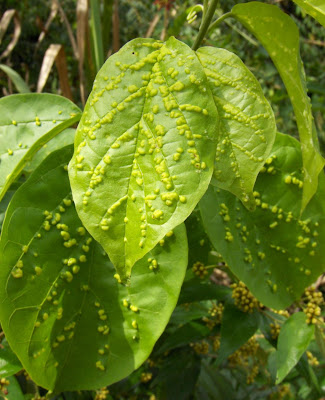

It seems that some things are part of the environment without any need to explain them. Take, for example, galls, or as I like to call them, "warts". In the top image you can see a bug
, one of the tortoise-shelled leaf beetles, which seems to be romancing a large, single gall on a manioc leaf (
Manihot esculenta). Now I've been seeing these galls for years and I've been asking about them for years without ever getting a satisfactory answer from anyone. Someone told me that they had something to do with ants, but I could never find any sign of them. Then one day while rambling around the internet, I discovered that they were galls. I forgot to earmark the reference but the explanation was that a small fly is the main player in this story. It lays its eggs on the upper surface of the leaf, which transforms into larvae. The larvae, in turn, cause abnormal cell growth on the leaves, thereby forming galls. Some manioc leaves are smothered in galls, other less so. The plant in the lower image is well covered, but I have a feeling that these galls may be caused by a different insect. Thanks to
Ted MacRae for identification of the beetle.

 It seems that some things are part of the environment without any need to explain them. Take, for example, galls, or as I like to call them, "warts". In the top image you can see a bug , one of the tortoise-shelled leaf beetles, which seems to be romancing a large, single gall on a manioc leaf (Manihot esculenta). Now I've been seeing these galls for years and I've been asking about them for years without ever getting a satisfactory answer from anyone. Someone told me that they had something to do with ants, but I could never find any sign of them. Then one day while rambling around the internet, I discovered that they were galls. I forgot to earmark the reference but the explanation was that a small fly is the main player in this story. It lays its eggs on the upper surface of the leaf, which transforms into larvae. The larvae, in turn, cause abnormal cell growth on the leaves, thereby forming galls. Some manioc leaves are smothered in galls, other less so. The plant in the lower image is well covered, but I have a feeling that these galls may be caused by a different insect. Thanks to Ted MacRae for identification of the beetle.
It seems that some things are part of the environment without any need to explain them. Take, for example, galls, or as I like to call them, "warts". In the top image you can see a bug , one of the tortoise-shelled leaf beetles, which seems to be romancing a large, single gall on a manioc leaf (Manihot esculenta). Now I've been seeing these galls for years and I've been asking about them for years without ever getting a satisfactory answer from anyone. Someone told me that they had something to do with ants, but I could never find any sign of them. Then one day while rambling around the internet, I discovered that they were galls. I forgot to earmark the reference but the explanation was that a small fly is the main player in this story. It lays its eggs on the upper surface of the leaf, which transforms into larvae. The larvae, in turn, cause abnormal cell growth on the leaves, thereby forming galls. Some manioc leaves are smothered in galls, other less so. The plant in the lower image is well covered, but I have a feeling that these galls may be caused by a different insect. Thanks to Ted MacRae for identification of the beetle.
4 comments:
Very interesting and informative blog, congratulations.
Thank you for posting a comment on my blog, I am happy you did, this way I could learn about your blog.
Keep-up the excellent work.
Cheers,
Wes
Many groups of insects (and non-insect arthropods) can cause galls - flies, wasps, and mites to name a few.
The "bug" is actually a beetle - one of the tortoise-shelled leaf beetles.
An interesting post. Sometimes when I'm walking I see things like this.
Dear Steven,
You may look to the site www.pflanzengallen.de
There You can see similar galls on other plants and may find an explanation. I think, the upper picture shows a gall of an aphid, and the lower picture a gall of a mites.
Post a Comment